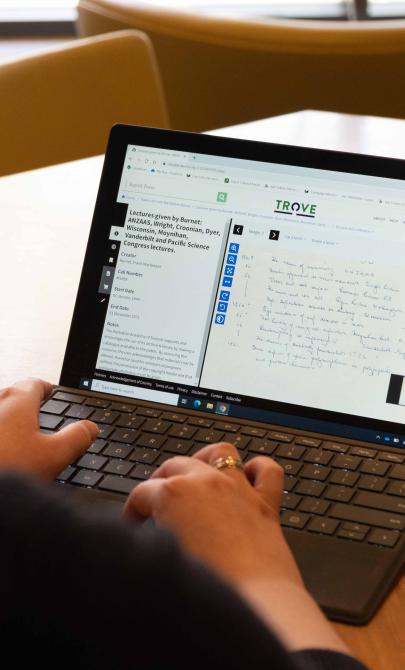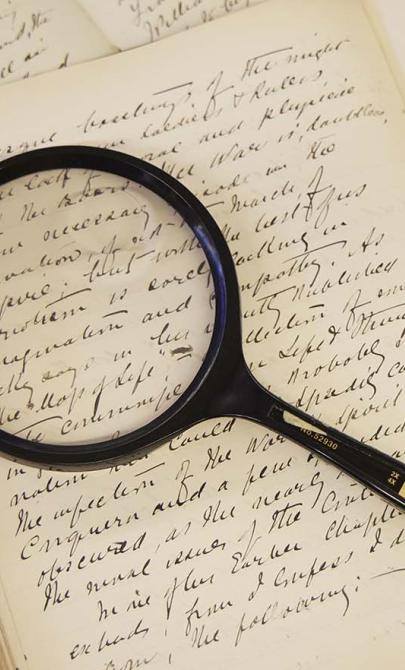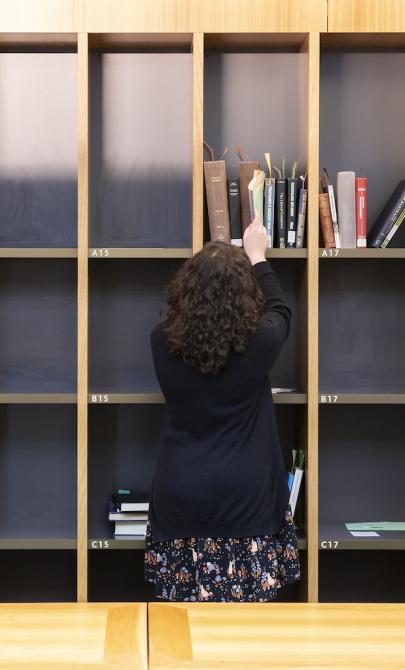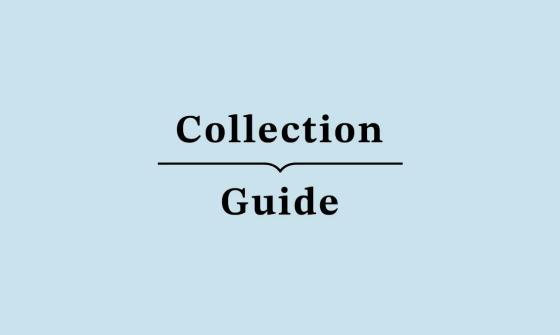Menzies Collection
Key items in the collection
Highlights from this collection demonstrate its historical significance and variety.
The papers of Sir Robert Menzies form the largest personal archive held in the Library.
They include:
- correspondence
- cards
- commissions
- diaries
- speeches
- invitations and other printed ephemera
- subject files
- newspaper cuttings
- photographs and cartoons.
They largely comprise papers that were kept in his offices in Melbourne and Canberra. Consequently, there are relatively few early papers or family papers. In addition, there are few Cabinet papers or official files, as Menzies was generally scrupulous about returning such records to his department.
The correspondence files range from 1935 to 1978, with the bulk of them dating from 1949 onwards. They form 2 sequences:
- one alphabetical
- the other chronological.
The latter tends to have more routine letters and many of them were evidently written by Menzies' private secretary, Hazel Craig, and signed by Menzies or Craig herself. In addition to the main sequences of correspondence, there are groups of files, some of them extensive, on subjects such as:
- engagements (1952–1978)
- press secretary
- elections
- Parliament
- Liberal Party
- banking
- defence
- Communist Party
- Suez, Rhodesia and South Africa
- cricket
- the Cinque Ports.
One of the great strengths of the collection is the set of speeches by Menzies dating from 1917 to 1972. Another strength is the set of Christmas cards, including cards from members of the British Royal Family dating from 1939 to 1994. Menzies only kept diaries on overseas trips and eventually abandoned the practice, but the diaries of his trips in 1935, 1941, 1948 and 1955 are detailed and are important sources.
The collection also contains the papers of Dame Pattie Menzies, extending to her death in 1994. They include correspondence with constituents, letters on her knighthood (1954) and the death of Menzies (1978), visitor and guest books (1940–1976), newspaper cuttings (1949–94) and photographs.
Although Menzies preferred writing and delivering speeches to writing letters, he necessarily wrote many thousands of letters in his long career. The following list is not exhaustive, but it indicates the range of collections in the Library that contain letters of Menzies:
- Papers of Sir George Pearce, politician
- Papers of Sir Frederic Eggleston, politician and diplomat
- Papers of JS MacDonald, gallery director
- Papers of Sir Thomas Bavin, politician
- Papers of Sir Ernest Scott, historian
- Papers of EL Piesse, lawyer and public servant
- Papers of Sir John Latham, politician, judge and diplomat
- Papers of WM Hughes, politician
- Papers of Leslie Bury, politician
- Papers of Herbert Brookes, businessman
- Papers of Sir Robert Garran, public servant
- Papers of Bessie Rischbieth, feminist
- Papers of EJ Ward, politician
- Papers of Sir Malcolm Ritchie, businessman and Federal President of Liberal Party
- Papers of Sir Keith Officer, diplomat
- Papers of Jessie Street, feminist
- Papers of Lord Gowrie, Governor-General
- Papers of Sir Keith Hancock, historian
- Papers of Sir Keith Murdoch, journalist
- Papers of Kenneth Slessor, poet and journalist
- Papers of Sir Henry Gullett, politician
- Papers of Sir Peter Heydon, diplomat and writer
- Papers of Frederick Osborne, politician
- Papers of Sir Douglas Copland, economist and academic (restricted)
- Papers of Sir Charles Marr, politician
- Papers of Sir Rex Nan Kivell, gallery director and collector
- Papers of JA Lyons, politician
- Papers of Sir Wilfrid Kent Hughes, politician
- Papers of Sir Eric Harrison, politician
- Papers of Sir Lionel Lindsay, artist
- Papers of PE Joske, politician and lawyer
- Papers of Sir Hubert Opperman, cyclist, politician and diplomat
- Papers of Paul McGuire, writer and diplomat
- Papers of Sir Ernest White, president of the Australian–American Association and the Liberal Democratic Party
- Papers of Sir Arthur Coles, businessman and politician
- Papers of Sir Irving Benson, clergyman
- Papers of Sir Randal Heymanson, journalist
- Papers of Sir Frederick Wheeler, public servant
- Papers of FH Wright, soldier and businessman
- Papers of Chester Wilmot, war correspondent
- Papers of Neil O'Sullivan, politician
- Papers of CR Hall, director of NSW Chamber of Manufactures
- Papers of Sir Keith Yorston, accountant and president of the Australian–American Association
- Papers of Sir Thomas White, politician
- Papers of Sir Donald Cleland, federal director of the Liberal Party and administrator of Papua New Guinea.
The Library holds the papers of Allan Martin (MS 9802), the bulk of which relate to his 2-volume biography of Menzies. In addition to correspondence and reviews of the book, and papers relating to other writings on Menzies, the papers contain 110 files of notes, transcripts, photocopies of debates, articles and other sources on Menzies' life. Many of them are from the Menzies papers, others were collected from libraries and archives all over the world. Of particular value are 24 drawers of index cards, providing chronological and alphabetical indexes to both public and private papers.
The papers of 2 other biographers are also held. In 1969 Menzies agreed that Frances McNicoll should be his biographer, but she eventually abandoned the project. McNicoll's papers consist of her correspondence with Menzies (1960–1978) and associates of Menzies, notes, research material, newspaper cuttings, tape recordings and transcripts. The papers of Cameron Hazlehurst include notes, drafts and typescripts of his book Menzies Observed (1979).
The Library holds recordings of 357 speeches made by Menzies between 1952 and 1967. They include speeches at election meetings and campaign rallies, lunches, dinners and the opening of buildings and exhibitions, press conferences, impromptu interviews, addresses to conferences, Liberal Party meetings and the United Nations.
A very large number of oral history interviews contain references to Menzies. The following are of special interest:
- Heather Rusden, Interview with Dame Pattie Menzies, 1990 (1 audio tape)
- John Farquharson, Interview with Hazel Craig, private secretary to Menzies, 1997 (6 audio tapes)
- Terry Colhoun, Interview with Tony Eggleton, press secretary to Menzies, 1998, 2003 (12 audio tapes, 4 sound files)
- John Farquharson, Interview with Stewart Cockburn, press secretary to Menzies, 2000 (2 sound files, restricted)
- Stewart Cockburn, Interview with Sir Robert Menzies, 1967 (1 sound cassette)
- John Bannister, Interview with Sir William Heseltine, private secretary to Menzies, 2005 (15 audio tapes).
The papers of Menzies contain many hundreds of photographs, and other photographs have been acquired from newspapers, the Australian News and Information Bureau and other agencies. While most of the photographs date from his time in Federal politics, there are a number depicting him as a child, student and young barrister.
In addition to official portraits, there are photographs of Menzies:
- with political colleagues and opponents
- at parliamentary sittings
- visiting royalty and heads of state
- at meetings of prime ministers and other international gatherings
- at openings of buildings and other public works
- at cultural events
- at cricket matches
- at many other events.
Menzies was a popular subject for cartoonists and the Library holds a number of original cartoons featuring him. The cartoonists include:
- John Frith
- Stewart McCrae
- Alain Moir
- George Molnar
- Ward O'Neill
- SG Wells.
Works by Menzies
- Afternoon Light: Some Memoirs of Men and Events (1967)
- Australia at War: Broadcast Addresses and Statements by RG Menzies (1939)
- Central Power in the Australian Commonwealth (1967)
- The Changing Commonwealth (1960)
- Dark and Hurrying Days: Menzies' 1941 Diary (edited by AW Martin and Patsy Hardy, 1993)
- The Forgotten People, and Other Studies in Democracy (1943)
- The Measure of the Years (1970)
- A People's War: Speeches (1941)
- Speech is of Time: Selected Speeches and Writings (1958)
Autobiographies of colleagues of Menzies
- Garfield Barwick, A Radical Tory: Reflections and Recollections (1995)
- Howard Beale, This Inch of Time: Memoirs of Politics and Diplomacy (1977)
- HC Coombs, Trial Balance (1981)
- John Cramer, Pioneers, Parties and People: A Political Memoir (1989)
- Fred Daly, From Curtin to Kerr (1977)
- Arthur Fadden, They Called me Artie: The Memoirs of Sir Arthur Fadden (1969)
- Paul Hasluck, The Chance of Politics (1997)
- James Killen, Killen: Inside Australian Politics (1985)
- Earle Page, Truant Surgeon: The Inside Story of Forty Years of Australian Political Life (1963)
- Percy Spender, Politics and a Man (1972)
- Alan Watt, Australian Diplomat: Memoirs of Sir Alan Watt (1972)
Biographies and Other Studies
- Troy Bramston, Robert Menzies: the art of politics (2019)
- Judith Brett, Robert Menzies' forgotten people (2007)
- John Bunting, RG Menzies, a Portrait (1988)
- Frank Cain, (editor), Menzies in War and Peace (1997)
- David Day, Menzies & Churchill at War: A Controversial New Account of the 1941 Struggle for Power (1986)
- Alexander Downer, Six Prime Ministers (1982)
- TR Frame, The Life and Death of Harold Holt (2005)
- Peter Golding, Black Jack McEwen: Political Gladiator (1996)
- Ian Hancock, National and Permanent? The Federal Organisation of the Liberal Party of Australia 1944–1965 (2000)
- Paul Hasluck, The Government and the People, 1939–1941 (1952)
- Paul Hasluck, Sir Robert Menzies (1980)
- Cameron Hazlehurst, Menzies Observed (1979)
- Anne Henderson, Menzies at war (2014)
- Gerard Henderson, Menzies' Child: The Liberal Party of Australia 1944–1994 (1994)
- WJ Hudson, Blind Loyalty: Australia and the Suez Crisis (1989)
- WJ Hudson, Casey (1986)
- Edgar Holt, Politics is People: The Men of the Menzies Era (1969)
- John Howard, The Menzies era: the years that shaped modern Australia (2014)
- Percy Joske, Sir Robert Menzies 1894–1978: A New, Informal Memoir (1978)
- David Lowe, Menzies and 'The Great World Struggle': Australia's Cold War 1948–1954 (1999)
- Robert Manne, The Petrov Affair: Politics and Espionage (1987)
- AW Martin, Robert Menzies, a Life (2 vols, 1993–99)
- Kevin Perkins, Menzies: Last of the Queen's Men (1968)
- Scott Prosser, JR Nethercote and JR Warhurst (editors), The Menzies Era: A Reappraisal of Government, Politics and Policy (1995)
- Alan Trengove, Menzies: A Pictorial Biography (1978)
- Alan Watt, The Evolution of Australian Foreign Policy, 1938–1965 (1967)
- Don Whitington, The Rulers: Fifteen Years of the Liberals (1965).
About Robert Menzies
Early life and education
The son of a storekeeper and shire councillor, Sir Robert Gordon Menzies (1894–1978) was born in the small town of Jeparit, Victoria. He was educated at the Humffray Street State School and Grenville College, Ballarat, and won scholarships to Wesley College and the University of Melbourne. He graduated in 1916 and was called to the Bar in 1918.
Legal career and entry into politics
He soon established a reputation as an outstanding barrister, especially when he won the Engineers Case in the High Court in 1920.
State political career
He became active in the National Party and in 1928 won a seat in the Victorian Legislative Council. In 1929 he was elected to the Legislative Assembly and in 1932 he became Attorney-General and Minister for Railways in the Argyle Government.
Rise to federal leadership
In 1934 Menzies moved to Federal politics, winning the United Australia Party seat of Kooyong, which he held until his retirement in 1966. He was immediately appointed Attorney-General and Minister for Industry in the Government of JA Lyons. He made his first visit to Britain in 1935.
First term as Prime Minister
On the death of Lyons in April 1939, Menzies was elected leader of the United Australia Party and became Prime Minister. His Government took the first steps to put Australia on a war footing. However, it only narrowly won the 1940 election and when Menzies returned from a long visit to Britain in 1941 he realised he did not have the full support of his colleagues. He resigned in August 1941 and 3 months later the Labor Party came to power.
The birth of the Liberal Party and political comeback
In 1943 Menzies regained the leadership of the United Australia Party. The Party was demoralised and fragmenting and Menzies played a key role in the formation of a new party – the Liberal Party – from 1944 to 1945. He lost the 1946 election, but in 1949 he won a resounding victory.
The Menzies era: 1949–1966
He was to be Prime Minister for the next 16 years, a record unequalled in Australian history. The coalition of Liberal and Country parties was remarkably united, whereas the Labor Party suffered a major split during 1954 to 1955 from which it did not recover until about 1970. The Government also benefited from a long period of economic prosperity. The Menzies era was characterised by massive immigration, the development of secondary industries, tariff protection, centralised industrial regulation, a ceaseless concern with communism both within Australia and in the Asian region, close ties with Britain and ambivalence towards the Commonwealth and the United Nations. Two areas in which Menzies took a strong personal interest were Federal involvement in education, especially the universities, and the development of Canberra as the national capital.
Retirement and honours
Menzies retired from politics in January 1966. He was knighted in 1963 and made Warden of the Cinque Ports in 1965.
Background to the collection
Sir Robert Menzies donated the first instalment of his papers to the Library in 1975 and a further instalment was transferred from his Melbourne office in 1976.
He bequeathed his remaining papers to the Commonwealth Parliamentary Library.
It was assumed that he had meant the National Library and the Parliamentary Library promptly directed that the papers be placed in the Library. They were received in 1978.
Further papers were presented by Heather Henderson, the daughter of Menzies, in 1998 and 2000. She also presented the papers of her mother, Dame Pattie Menzies, in 1995.
The Menzies papers are held in the Manuscripts Collection. They occupy 588 boxes. A 38-page finding aid, covering the papers acquired from 1975 to 1978, is available in the Special Collections Reading Room, together with lists of the later instalments and a complete list of the speeches. A summary of the collection.
The papers of AW Martin occupy 54 boxes and the papers of Frances McNicoll occupy 16 boxes. There is a 14-page finding aid for the Martin papers and a McNicoll papers finding aid.
The recordings of speeches and interviews are housed in the Oral History and Folklore Collection at various locations. All the speeches in TRC 1169 have been catalogued individually, as have the various interviews with Menzies, his wife and his colleagues.
The original cartoons and about 130 photographs of Menzies are held in the Pictures Collection at various locations. A much larger number of photographs can be found in the Menzies papers in the Manuscripts Collection, mostly in series 9. The publications are held in the Australian Collection.
Most of the books from Menzies' private library are kept together as a collection in the Baillieu Library in the University of Melbourne.
This guide was prepared using these references:
- AW Martin, Menzies, Sir Robert Gordon (Bob) (1894–1978), Australian Dictionary of Biography Online.
- Graeme Powell, The First in the Field: Prime Minister's Papers in the National Library of Australia, Australian Academic and Research Libraries, vol 36 (1), March 2005, pp 54–64.
- Graeme Powell, Prime Ministers as Record Keepers: British Models and Australian Practice, in Sue McKemmish and Michael Piggott (editors), The Records Continuum: Ian Maclean and Australian Archives First Fifty Years, Ancora Press, Melbourne, 1994, pp 93–109.




